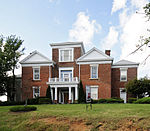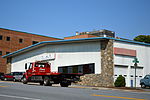B & B Motor Company Building
Buildings and structures in Asheville, North CarolinaBuncombe County, North Carolina Registered Historic Place stubsCommercial buildings completed in 1925Commercial buildings on the National Register of Historic Places in North CarolinaNational Register of Historic Places in Buncombe County, North Carolina

B & B Motor Company Building is a historic auto showroom and service center located in Asheville, Buncombe County, North Carolina. It was built in 1925, and is a two-story reinforced concrete and structural clay tile building faced in brick. It features limestone trim and a high decorated parapet.It was listed on the National Register of Historic Places in 1979.
Excerpt from the Wikipedia article B & B Motor Company Building (License: CC BY-SA 3.0, Authors, Images).B & B Motor Company Building
Hilliard Avenue, Asheville
Geographical coordinates (GPS) Address Nearby Places Show on map
Geographical coordinates (GPS)
| Latitude | Longitude |
|---|---|
| N 35.591111111111 ° | E -82.554722222222 ° |
Address
Hilliard Avenue 188
28801 Asheville
North Carolina, United States
Open on Google Maps








